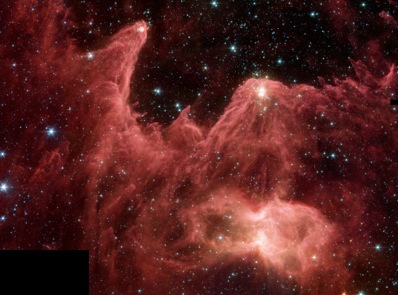
Dusty experiments solve interstellar water mystery
DR EMILY BALDWIN
ASTRONOMY NOW
Posted: 14 April


Scientists presenting their results at today’s National Astronomy Meeting announced that dust plays an essential role in the formation of water in interstellar space.
It is widely agreed that Earth’s water was delivered through cometary impacts during the Solar System’s planetary construction phase, and that comets were formed from interstellar material left over following the birth of the Sun, “but the next step back has been unclear,” says Victoria Frankland of the Heriot-Watt University.
Frankland and colleagues say that dust grains, which make up just one percent of the interstellar medium are the key, providing a surface that not only helps important chemical reactions to take place but also enables an icy coating to build up over time.
 Vast clouds of gas and dust that accumulate in the interstellar medium are known to contain over 120 different molecular species. Image: NASA/JPL-Caltech/L. Allen (Harvard-Smithsonian CfA). Vast clouds of gas and dust that accumulate in the interstellar medium are known to contain over 120 different molecular species. Image: NASA/JPL-Caltech/L. Allen (Harvard-Smithsonian CfA).
Exposed to the harsh radiation fields of interstellar space, few molecules escape being broken down, yet vast clouds of gas and dust that accumulate in the interstellar medium are known to contain over 120 different molecular species. Although hydrogen atoms are extremely common, water’s other constituent, gaseous molecular oxygen (O2) has only been detected in limited quantities. Atomic oxygen (O) is quite plentiful, but gas phase reactions between hydrogen and atomic oxygen can’t account for the amount of water observed. Even the observed quantities of atomic oxygen suggest that some is missing in star-forming regions compared to the rest of interstellar space.
The low temperature, low pressure conditions within the interstellar medium limit the range of chemical reactions that can take place but Frankland’s team have pioneered experimental techniques to learn how such reactions might occur in these harsh environments.
“We set up our experiments in a vacuum chamber and cool it down to –268 degrees Celsius, then use surface sensitive techniques to explore the physical and chemical behaviour of oxygen atoms and molecules on the surfaces of dust and ice grains,” she explains.
So far the experiments have explored how the surfaces of dust particles affect the reactions of oxygen in its various forms, but the team are working toward combining atomic beams of oxygen and hydrogen to study in situ water formation on a grain surface.
“These initial experiments are having some interesting results in that they are allowing us to look at how the ice coating develops on the dust particles,” says Frankland. “It appears that oxygen atoms may become trapped inside the icy mantles. We need to do more work, but it may be that our experiments might help solve the mystery of the missing atomic oxygen as well as where the water has come from.”
|



